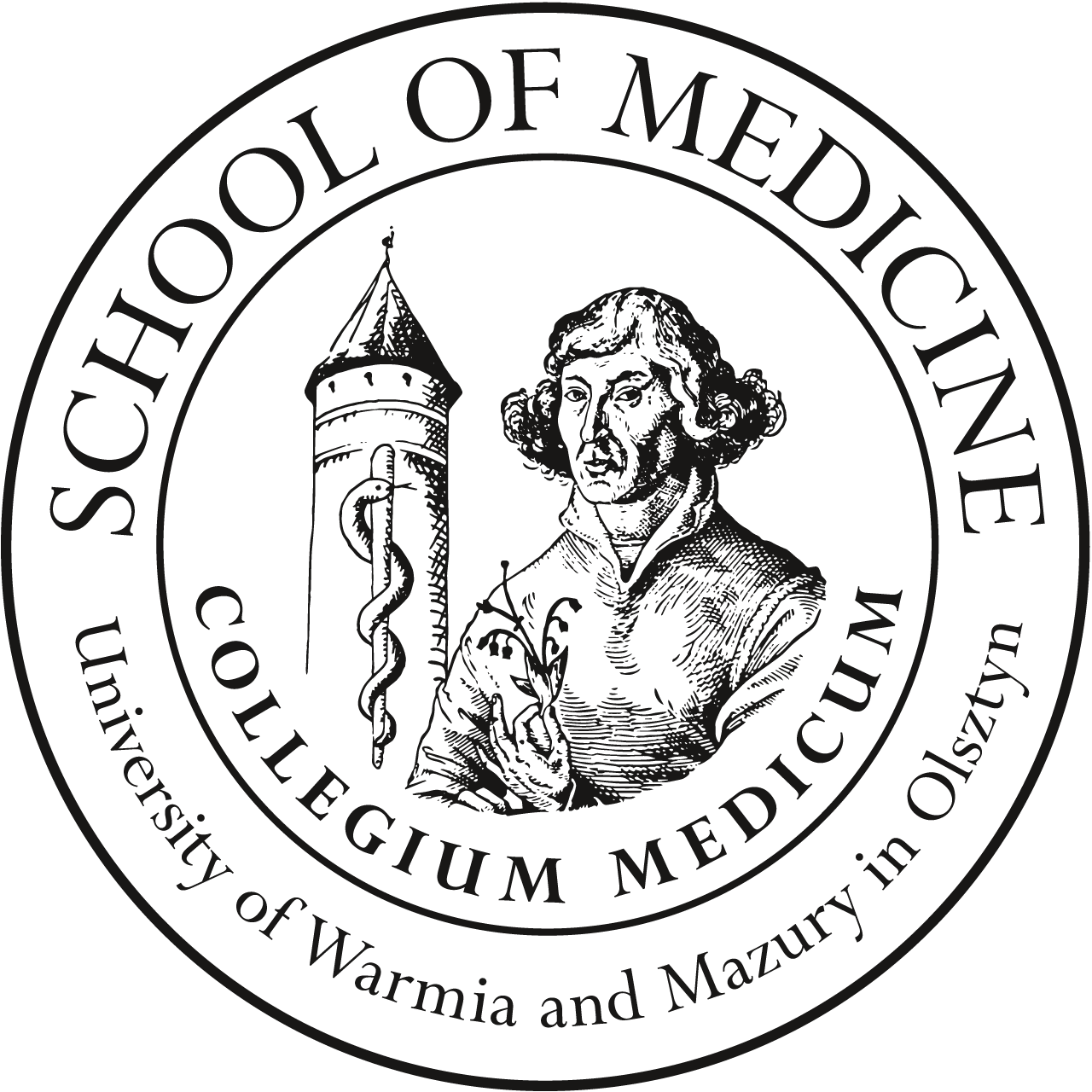SCHEDULES AND THEME
SCHEDULES - AT THE END OF THE PAGE !!!
PEDIATRICS
Winter semester
VI Year
[Gastroenterology/Pulmonology/Infectious Diseases/ Oncology and Haematology/Neonatology/ Neurology/ Rheumatology/Allergology/Ophthalmology/Laryngology
To participate in the practical classes, students have to fulfill the condition – knowledge of the topics from previous years.
ATTENTION: The sequence of topics may change during the semester according to the schedule for Pediatrics. Due to the wide range of material, we recommend earlier preparation.
A test, which covers the topic from the particular exercise and the material from the previous years, will be taken before every practical class.
Classes will take place in the Regional Specialistic Children’s Hospital in Olsztyn or in the
Medical Simulation Center
Practical classes 90 h | Practical activities taking place in an assigned WSSD department or in the Medical Simulation Centre in groups of five, under the supervision of an assistant. Credit for each day on the basis of student activity: passed/unpassed. The student must pass each exercise. In case of failure, there is a possibility of improvement with the assistant or the Head of the Department. |
Seminars 30 h | Include discussion of aspects of selected disease units. They are preceded by a test consisting of three to five open or test questions. Credit - correct answers to a minimum of two questions out of three or minimum of three out of five questions. |
GASTROENTEROLOGY. Gastrointestinal emergencies.
Before the class the student should know the anatomy and physiology of the GI truck, liver, pancreas, bilirubin metabolism, previous topic from gastroenterology and nutrition.
Topic 1: Inflammatory - bowel disease in children. Ulcerative colitis, Crohn’s disease, non-specific colitis
Ulcerative colitis, Crohn’s disease, non-specific colitis. Clinical presentation, differentia diagnostics, laboratory testing, endoscopy, imaging, pharmacological treatment, biological treatment, feeding therapy, complications. Discussion of the selected cases.
Topic 2: Chemical burns of the esophagus. Gastrointestinal foreign bodies. Bleeding of the upper and lower part of the gastrointestinal tract
Clinical presentation, differentia diagnostics, laboratory testing, endoscopy, imaging, pharmacological treatment, feeding therapy, complications. Discussion of the selected cases.
Topic 3: Vomiting in children. Chronic diarrhea in children
INFECTIOUS DISEASES. Emergencies. Selected diseases.
Before the class student should know etiology of the viral and bacterial diseases in children – transmission, incubation period, symptoms, diagnostics, treatment, prevention. Medications: anti-viral, antibiotics. Vaccinations: types, schedule, contraindications, adverse event.
Topic 1: Vaccination in the special situations.
Vaccinating children with congenital and acquired immune deficiencies, with chronic diseases. Emergency situations: qualification for anti-tetanus and anti-rabies vaccination. Procedure in the event of parents' lack of consent for vaccination. Discussion based on cases.
Topic 2: Sepsis in children. Invasive pneumococcal disease. Meningitis.
Etiological factors 1 / bacterial Neisseria meningitidis, Streptococcus pneumoniae, Haemophilus influenzae, Escherichia coli, group B streptococci, Staphylococcus aureus, Mycobacterium tuberculosis, Listeria monocytogene, 2 / viral. The routes of infection, clinical picture, differences in children, differential diagnosis, treatment, complications, prevention. Discussion of selected cases.
IONCOLOGY. Oncological emergencies.
Before the class student should know the parts and physiology of the haematopoietic system, lymphoid organs, immune system (humoral and cell-mediated immunity, antibodies), previous topics from the oncology and hematology.
Topic 1: Symptomatology, taking history, physical examination in oncology and hematology.
Epidemiology. Oncogenesis. Cases presentation.
Topic 2: Solid tumors in children:
Neuroblastoma, Wilm’s tumor, tumors of the bones (osteosarcoma, Ewing’s sarcoma), soft tissue tumors, liver tumors, germ cell tumor, histiocytosis, CNS tumors. Hemangiomas and congenital malformations in children. Principles of the diagnostics procedures, therapy. Cases presentation – interpretation of the laboratory test and images. TNM staging system.
Topic 3:Oncological emergencies.
Early complications of the antineoplastic therapy in children. Late effects of treatment for cancer, bone marrow transplantation. Outpatient care of the child during the antineoplastic therapy. Follow – up after the treatment. Cases presentation.
Topic 4: Immunodeficiency disorders in children.
Symptomatology of the immunodeficiency disorders. Primary immunodeficiency disorders in children: shortage of subclasses IgG, isolated IgA deficiency, common variable immunodeficiency (CVID), severe combined immunodeficiency (SCID) ,X-linked agammaglobulinemia, Wiskott –Aldrich syndrome, ataxia0telangiectasia, hyper – IgM syndrome, hyper – IgE syndrome, resistance syndromes associated with lymphocytes T, congenital neutropenia, chronic granulomatous disease. Acquired immunodeficiency disorders in children. Diagnostic, therapeutic management, treatment programms. Case presentation.
RHEUMATOLOGY
Before the class student should know the anatomy and physiology of the muskuloskeletar system, humoral and cell-mediated immunity, types of the antibodies, adaptive immune system, non-specific immune system, major histocompatibility complex, cytokines, autoimmunity.
Topic 1:Diagnosis of rheumatic diseases in children. Differences in the course of connective tissue diseases in children.
Clinical presentation, differential diagnosis, laboratory tests, imaging, follow-up. Discussion of the selected cases.
Topic 2:Differential diagnosis of arthritis in children.Reactive arthritis. Juvenile rheumatoid arthritis.
Clinical presentation, differential diagnosis, laboratory tests, imaging, follow-up. Discussion of the selected cases.
NEUROLOGY. Neurological emergencies.
Before the class a student should know the anatomy and physiology of the CNS, milestones in children, psychomotor development assessment, principles of the neurological exam in children.
Genetics basis of the neurological disorders.
Topic 1: Neurological examination in children. Cerebral palsy. Epilepsy. Non-epileptic seizures. Febrile seizures.
Clinical presentation, differentia diagnosis, laboratory test and imaging, treamtent. Discussion of the selected cases.
Topic 2: Headaches. Neurodegenerative disorders in children.
Clinical presentation, differentia diagnosis, laboratory test and imaging, treamtent. Discussion of the selected cases. Follow up.
NEONATOLOGY.
Topic 1 : Prematurity and its complications (respiratory distress syndrome, bronchopulmonary dysplasia, retinopathy, necrotizing enterocolitis, periventricular hemorrhage, leucomalacia, osteopenia of prematurity, anemia).
Bronchopulmonary dysplasia, retinopathy of prematurity, necrotizing enterocolitis, intraventricular hemorrhages, hypoxic-ischemic encephalopathy.
Topic 2: Congenital infections (bacterial, viral, other). Early and late neonatal infections. Etiology, epidemiology, prevention, diagnosis, symptomatology, treatment of infections in the neonatal period.
Early and late – onset infections (GBS). Maternal to fetal infections, TORCH , CMV.
Topic 3: Emergency conditions in neonatology - perinatal injuries, hypoxic-ischemic encephalopathy, selected metabolic diseases. Congenital malformations requiring intervention in the neonatal period ( defects of the gastrointestinal tract, urinary tract, nervous system, ductal heart defects).
Severe congenital malformations. Neonatal seizures. Metabolic disorders. Pathological jaundice.
NEUROSURGERY
Topic 1: Congenital anomalies of the head and central nervous system. Dysmorphology, diagnostics and treatment
Revision of the functional and clinical anatomy of the head and neck region.
Anatomical and clinical differences of the head and neck of a neonate, small child and teenager.
Examination of the head and neck region with aspects of neurological, developmental and dysmorphological knowledge.
Dysmorphology of the head and neck (clefts of the palate and lip, congenital anomalies of the facial skeleton, craniosynostoses, positional plagiocephaly. Congenital anomalies of the central nervous system. Introduction to pathogenesis, diagnostics and treatment of congenital anomalies and diseases of neonates and children:
- hydrocephalus;
- dysraphism – spina bifida, meningocele, meningomyelocele, intraspinal lipoma, dermal sinus, cranium bifidum, encephalocele;
- disorders of neuronal migration – lissencephaly, schizencephaly, pachygyria, polymicrogyria, neuronal heterotopias;
- white matter congenital anomalies – corpus callosum agenesis;
- deformational plagiocephaly;
- agenesis of cranial nerves and dysgenesis of posterior fossa;
- microcephaly
- craniosynostoses – non-syndromic craniosynostoses, complex craniosynostoses, syndromic craniosynostoses;
- neurocutaneous syndromes – neurofibromatosis type I, neurofibromatosis type II, tuberous sclerosis;
Ophthalmology
Topic 1:Emergencies in pediatric ophthalmology
During the classes, the most common causes of injuries in children,methods of treating them and procedures in the pediatric emergency room will be discussed.
The student joining the course has basic knowledge of pediatric and ophthalmology.
He or she will be able to asses an eye injury, remove a forign body from the eye in a outpatient clinic and use ophthalmological drugs after an injury.
Laryngology


